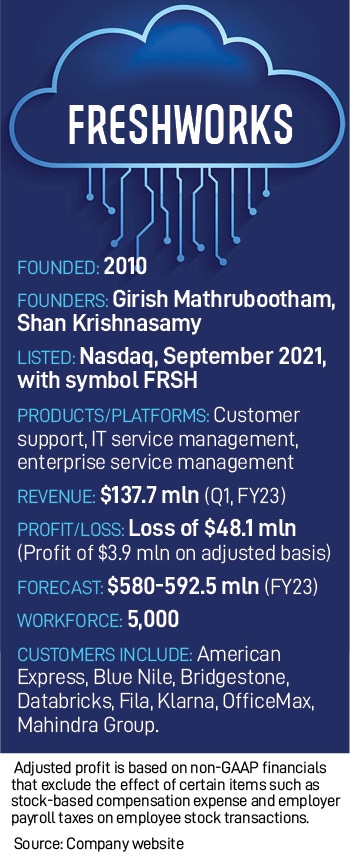How Freshworks wants to tap Generative AI and go after larger customers
Harnessing technologies like GPT and Copilot, the Nasdaq-listed software company plans to ramp up its own growth


It was a slightly overcast morning in Bengaluru, with intermittent drizzling, as many software developers, almost all of them in their 20s, walked into a building named Aquila – from the Latin word for eagle, and a constellation in the northern hemisphere – to attend a Freshworks conference, recently. The monsoons were still playing hide and seek with India.
Taking the lift several floors up, they entered a large hall, big enough for an Indian wedding reception, on loan to Freshworks for the event from one of Amazon’s development centres, the main occupant of the building, located in one of many in the tech parks on Bengaluru’s outer ring road.
Neighbouring buildings included Orion, Taurus and Carina, and some of the neighbours were Samsung, Qualcomm, Google, and Red Hat. Inside the hall, there was everything from south Indian breakfast to espresso shots for the bleary-eyed night-owl coders on offer who might have crawled away from their screens to attend the event. As part of the opening session of the event, Freshworks’s Founder and CEO Girish Mathrubootham appeared onscreen, with a short, prepared message.
The audio was slightly out of sync with the visual, but the message was simple, and to the point. Freshworks wants to make life easy, and even fun, for developers to build great apps for its ecosystem. Software companies typically offer such apps on their marketplaces for customers to directly download and start using.
“App building used to be an affair where you had to spend time learning the Freshworks ecosystem, learning the SDKs (software development kits), familiarising yourself with the APIs (application program interface), and spending a lot of time writing code, testing it, documenting your code, checking it in," Mathrubootham says. “I am super thrilled to get Freddy Copilot for developers in your hands today. And you are going to be thrilled with how easy it is to start building apps for Freshworks."
It helps developers with many of the mundane, but necessary, tasks that go with app building, so “you can focus on quickly building your apps and getting it live," Mathrubootham tells the audience.
 This effort to engage more deeply with developers is one of many initiatives at Freshworks to go after the larger customers (often called enterprise customers, as against SMB customers for small and medium sized businesses) whose orders can help the company grow faster, and even become profitable. But such customers also demand more robustness and depth than the SMB segment that Freshworks grew up serving.
This effort to engage more deeply with developers is one of many initiatives at Freshworks to go after the larger customers (often called enterprise customers, as against SMB customers for small and medium sized businesses) whose orders can help the company grow faster, and even become profitable. But such customers also demand more robustness and depth than the SMB segment that Freshworks grew up serving.
Freshworks operates in three major market segments, developing software for customer support teams, IT teams, and other departments like HR, finance, and legal, as well as software for sales teams and marketers. Almost all of this is amenable for a big infusion of generative artificial intelligence (AI).
Mathrubootham’s motto now is to build software for the “Fortune 5 million" whereas many software companies focus on the world’s biggest 500 companies. That said, the company is undergoing an irreversible transition—as it seeks to become a billion-dollar-revenue business—towards making software for an ever-larger enterprise customer.
“Initially, we catered primarily to small businesses, but as we"ve grown, our products have evolved to handle larger customers, including those with millions of their own customers," Dennis Woodside, president at Freshworks, says.
For example, Purplle, a well-known company in India, has around seven million customers who frequently require support and have their questions addressed. Freshworks offers automated bots to answer questions or direct users to FAQs, he says.
As Freshworks expands its product suite, its customers range from Viessman in Europe, for its IT service management software, and S&P Global, a financial services company, to DTDC, one of India’s biggest logistics businesses.
“We"re steadily entering larger accounts as our product matures and becomes more versatile," Woodside says. These markets represent multibillion-dollar opportunities, so Freshworks’s potential for growth is significant, he says. However, its challenge lies in raising its brand recognition across its customer base, especially in the US and western Europe.
Woodside, who joined the company about a year ago, says one of the company"s strengths has been its ability to generate demand through “inbound marketing." Larger enterprise customers require a different approach. For this, in recent years, Freshworks has also established a more traditional field sales team – operating primarily in the US and Europe, but also some parts of Asia, and focusing on selling to larger customers.
Selling to companies with several thousand employees involves a more complex process compared to smaller companies. Some large customers do go through the trial evaluation process, Woodside says, but many also require legal and security reviews. To navigate these complexities, experienced sales professionals are crucial in assisting customers through the entire sales process.
This is one of the areas that Woodside, who has prior experience of running large operations at companies including Google and Dropbox, has worked to strengthen.
Here’s a small specific example of the kinds of changes he has implemented. As the sales team was built out, the distinction between the roles of the field team and the inbound team became blurred, he says. “Field representatives were receiving leads that could have been converted through our well-established inbound engine."
So, Freshworks redefined the line between the field and inbound teams, allowing the inbound team to handle customers with up to 500 employees. Second, they separated the responsibilities within the field team, distinguishing between acquiring new business and growing existing accounts.
“Each requires distinct skills, and we aim to excel in both areas," Woodside says.
To support its growth ambitions, Freshworks has also brought in experienced leaders from companies like Salesforce and Zendesk in North America, France, Benelux, and APMEA (Asia Pacific, Middle East and Africa), to mentor and coach its sales teams to go after larger deals.
For example, in February, Freshworks named Sandie Overtveld as senior vice president for Asia Pacific, Japan and Middle East and Africa. Overtveld has been in the industry for 30-plus years, with experience from Microsoft, Hewlett Packard and Zendesk.
 Dennis Woodside, President, Freshworks
Dennis Woodside, President, Freshworks
Freshworks’s core customer base primarily consists of companies with up to 5,000 employees, while its software can scale to serve much larger companies, like Mahindra Group, for example, a customer in India with 250,000 employees.
Many successful businesses have followed a similar trajectory from small to large, recognising the importance of designing a product that offers fast time-to-value and ease of use, Woodside says.
Companies like Amazon Web Services, today a cloud giant, and Australian SaaS company Atlassian, a collaboration software vendor, started by targeting smaller businesses or specific teams within larger organisations, gradually expanding to bigger customers.
By revenue, Freshworks has two “thresholds." One is $5,000 in ARR (annual recurring revenue) and then the second is $50,000. “Our growth is increasingly being driven by the larger accounts," Woodside says. Those spending more than $50,000 a year on Freshworks’s software are growing faster than those spending more than $5,000.
And that"s important to Mathrubootham and Woodside, and chief product officer Prakash Ramamurthy, because it shows that the products retain their value for smaller customers, but are also relevant and finding acceptance with the larger enterprises. Freshworks’s customers include American Express, Blue Nile, Bridgestone, Databricks, Fila, Klarna, and OfficeMax.
“Part of our stated strategy is to continue to serve larger and larger customers," Woodside says.
With that strategy, Nasdaq-listed Freshworks delivered its first quarter of profitability this year, for three months ended March 31, albeit on an “adjusted" non-GAAP basis (generally accepted accounting principles, the widely used international standards).
“We are confident in sustaining our performance and have provided guidance for profitability on a non-GAAP basis and positive cash flow for the full year," Woodside says.
Software products generally offer high profit margins, and if Freshworks manages its costs effectively, it can achieve strong bottom-line results. Despite some challenges in the customer support sector due to companies reducing their agent count, the company achieved 23 percent growth on a constant currency basis last quarter, he says. On the other hand, the company’s ITSM [IT service management] business is performing “exceptionally well."
The company also has the money to invest in growth, with $1.2 billion in cash reserves.
Becoming a billion-dollar-revenue now seems like only a matter of time, unless events beyond Freshworks’s control – like a possible recession in the US or escalating conflict with China and so on – get much worse than anticipated. Freshworks expects revenue to be in the range of $580 million to $592.5 million for the full fiscal year, a 16-19 percent growth over 2022.
Others have done this before – hitting $1 billion in sales and going well past that. Freshworks’s larger competitors such as Zendesk and Salesforce"s Service Cloud, are examples on the customer support side. On the ITSM side, BMC Software and Cherwell Software are such businesses. HubSpot, which focuses on sales and marketing for small businesses, has grown into a $2.5 billion revenue company in a relatively short span.
The markets Freshworks serves are large and still fragmented, with scope for many more companies to come up and grow into multi-billion-dollar businesses.
The company’s 5,000 or so employees, mostly based in India, serve some 60,000 customers. Now the focus is on bringing AI to the masses – the top five million companies around the world.
Also listen: Dennis Woodside on Freshworks" $1 billion plan and beyond — Part 1
Like other companies in the thick of reinventing themselves in the age of AI, Freshworks uses open data from the web (like how ChatGPT was trained) plus its own customer-specific data and data from customers. The three sets together help to make training various models more effective.
In addition to publicly available data and software, Freshworks has developed its own technology to search and learn from both company-wide and customer-specific information, Woodside says.
From a functional standpoint, AI enhances the effectiveness of Freshworks’s products today. It can provide suggestions for complex questions, help summarise interactions with customers, and equip sales and customer support agents with tools and insights that weren’t available without AI.
Overall, AI experts, including at Freshworks, recognise the need for human moderation of AI at this stage of the development of the tech as an industry. The self-service component of Freddy AI is customer facing and aimed at reducing workload through automation – an example of how humans can be freed up for higher-level work.
Other areas where Freddy AI will help include helping agents to deliver better customer service, and extracting insights useful to managers to improve their operations.
While ChatGPT is probably known more widely, GitHub Copilot is an AI-powered coding assistant developed by GitHub and OpenAI. It uses OpenAI"s Codex, a language model trained on a wide range of programming languages and coding practices. It is designed to assist developers in writing code by providing suggestions and autocompleting code snippets directly in their integrated development environments (IDE).
In the case of Freshworks’s virtual assistant Freddy AI, it uses a clutch of technologies together called Azure Cognitive Services to offer three flavours: Copilot, Self Service and Insights. Freddy Copilot offers contextual assistance, offloads repetitive tasks, and maximizes team productivity, the company said in a press release on June 21, announcing the product.
Freddy started out as a “natively built, AI-powered assistant." In March, this year, Freshworks announced beta versions of various capabilities of Freddy, now using OpenAI’s GPT large language models (LLMs). On June 21, the company unveiled the new Freddy AI solutions.
They help developers and employees in support, sales, and marketing to use conversations to get their work done. Freddy Self Service offloads monotonous work to bots to scale support and deliver better customer experiences.
And Freddy Insights automates the analysis of users’ daily productivity and provides recommendations to improve their work’s effectiveness.
Freshworks’s goal is to have Freddy AI solutions unify the strengths of a range of LLMs (large language models) to optimise business performance and speed up deployments of software applications. Freshworks will build out proprietary language models and incorporate general purpose LLMs to address customer specific needs, the company said in the press release.
Freshworks has an opportunity to bring more productivity and proactive insights to businesses of all sizes, helping them turn generative AI into growth, Chief Product Officer Ramamurthy says.
He adds: “For far too long companies have spent time and energy training humans to understand software. Now with generative AI, products are learning to adapt to how humans think."
First Published: Jul 03, 2023, 13:34
Subscribe Now